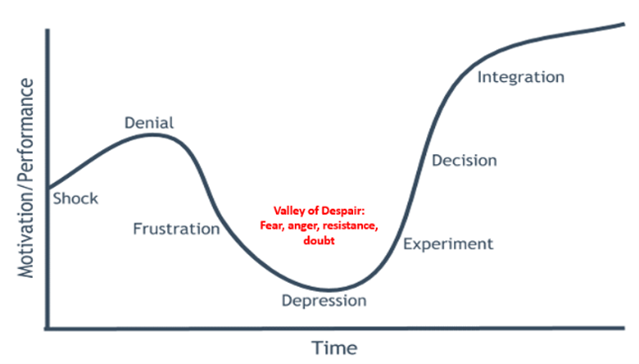Engaging users is vital to successful business transformation
Today, the pace of change in virtually every industry is at an all-time high. The traditional 5-year or even 3-year plan is inadequate to keep up with the competition. Companies that previously enjoyed the luxury of slow technical change are now faced with compressed product development times, new and quicker competitors, and more demanding customers. Staying up to speed with the latest innovations in your industry requires almost constant change.
Top executives are aware of the imperative for change. A survey by Gartner concluded that 80% of CEOs have a business transformation project of some type underway. Likewise, most business transformation projects take twice as long as planned and cost twice as much. This doesn’t even include the projects that get planned but never get off the ground.
In the Product Lifecycle Management (PLM) space, everyone can think of a prior PLM selection and deployment activity that did not work out well. The failure often comes when introducing a new PLM solution to unsuspecting users, and chaos ensues. By planning and involving those who will be affected, you can deliver a more successful PLM tool to your users and get kudos instead of a black eye.
We must face the fact that most people do not want to change. When new software is deployed along with new processes, new tasks, and possibly organizational changes, most people are not happy. Most PLM users will not shout or throw things when sudden process changes appear, but they will try hard not to adopt the new solution because they lack the understanding of how that solution helps them and the enterprise.
Statistics from McKinsey & Co. shows that 70% of business transformation efforts fail. The primary reason for this failure is a lack of management support and a lack of employee buy-in. This has certainly been the case for many PLM rollout activities that have not ended well.
The importance of getting management and employees on the same page very early in the PLM selection process cannot be overstated. The same survey showed that when people are involved early in the change process, it is 30% more likely to stick.
The Kubler-Ross change curve below shows the various stages of adapting to change. If PLM users can be involved early in the solution selection process, they will be able to quickly move through the first stages of accepting change and are more likely to be ready when the changes arrive. A good cultural change management plan will allow this to happen at the beginning, middle, and end of the PLM selection project. This plan can also guide users as they become familiar with the new software and likely help them prepare for the next phase of change.

Too often, an impending PLM solution replacement is not communicated to the masses because there might be a general mutiny. Getting people involved in the actual selection process is an excellent way to engage early with PLM users and other business organizations that must collaborate. Don’t paint a rosy picture, but be honest about what will change and provide a good overview of the many benefits that this new PLM solution will bring to the business. A simple overview communicated early to all users and stakeholders should provide answers to the following questions:
- What is the plan for selecting a PLM solution?
- Why do we need to make this change?
- What are the benefits that we will receive?
Telling people what will not change can also help potential users feel better about the project. Some PLM changes will impact many people, but when done in a phased approach, it can be less invasive. Make sure to tell everyone what the process will be and what will change with each phase of PLM software deployment. Most people will be able to deal with the uncertainty if they know what to expect. (I also recommend providing free pizza when possible.)
Many of the challenges that appear with PLM users after the software is deployed could have been dealt with and solved long before the solution was chosen. Take the time up-front to listen and let those most affected by these changes know that you have their best interests in mind. Get their feedback and involve them in the PLM selection process so they may transform from a complainer to a champion. If your PLM software allows customizations, agreeing to a custom request from your users early in the selection process will go a long way in fostering goodwill. The change management plan should include an outline of what will be done to support PLM users during the selection process and after the software is installed. This is where many selection projects fail. Don’t just install the software and step away. Include a support section in your plan that includes internal hotlines, mentors, demos that target particular questions, internal user groups, frequent update training, and other support resources for all users.
Here are several ways you can be more successful:
- Develop a detailed cultural change management plan
- Provide feedback to users during the entire process
- Personalize the experience by answering questions
- Remove executive roadblocks by having a committed sponsor
- Build a community of PLM users that support each other
- Demonstrate progress phase by phase
- Expect that plans will have to change as users identify issues during early tests
- Make sure that the solution is actually used and if not, why not
Supporting your users through the PLM selection and deployment process will pay big dividends when the solution is fully implemented. Instead of users that are constantly asking why this change was made, you will have users excited about the new things they are learning and asking when the next phase will be deployed. This entire process can make your users more change-capable, and their adoption of future solutions will be faster.
PLM solutions are powerful and can support the changes organizations must make to allow their business to keep up with the competition. Make sure that you do not let the tool drive the solution. Determining what you need to support your business in the future should include asking users what they would like to do better. The best solutions will have a mix of processes that are key to the business and processes that are the easiest for users to execute.
The many changes introduced by a PLM solution deployment are successful when users and management are in sync and understand the benefits of PLM.
But don’t take my word for it; look at our PLM selection guide to help you successfully choose your new PLM solution AND deploy it to happy and excited users.

